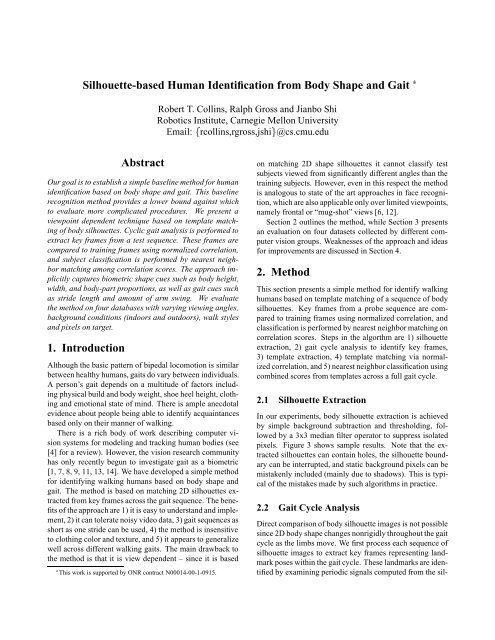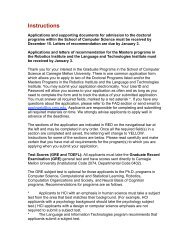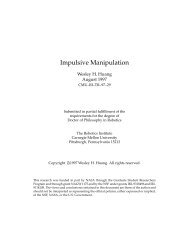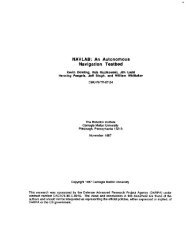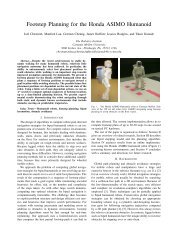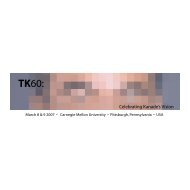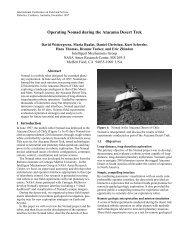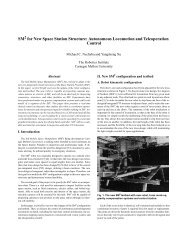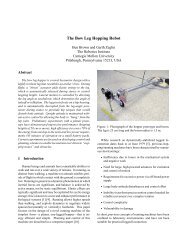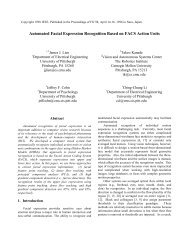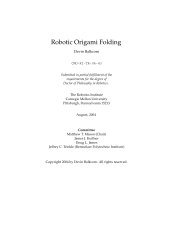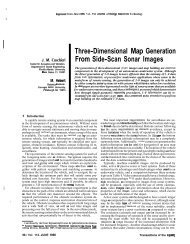Download as a PDF - CiteSeerX
Download as a PDF - CiteSeerX
Download as a PDF - CiteSeerX
Create successful ePaper yourself
Turn your PDF publications into a flip-book with our unique Google optimized e-Paper software.
Silhouette-b<strong>as</strong>ed Human Identification from Body Shape and Gait £<br />
Abstract<br />
Our goal is to establish a simple b<strong>as</strong>eline method for human<br />
identification b<strong>as</strong>ed on body shape and gait. This b<strong>as</strong>eline<br />
recognition method provides a lower bound against which<br />
to evaluate more complicated procedures. We present a<br />
viewpoint dependent technique b<strong>as</strong>ed on template matching<br />
of body silhouettes. Cyclic gait analysis is performed to<br />
extract key frames from a test sequence. These frames are<br />
compared to training frames using normalized correlation,<br />
and subject cl<strong>as</strong>sification is performed by nearest neighbor<br />
matching among correlation scores. The approach implicitly<br />
captures biometric shape cues such <strong>as</strong> body height,<br />
width, and body-part proportions, <strong>as</strong> well <strong>as</strong> gait cues such<br />
<strong>as</strong> stride length and amount of arm swing. We evaluate<br />
the method on four datab<strong>as</strong>es with varying viewing angles,<br />
background conditions (indoors and outdoors), walk styles<br />
and pixels on target.<br />
1. Introduction<br />
Although the b<strong>as</strong>ic pattern of bipedal locomotion is similar<br />
between healthy humans, gaits do vary between individuals.<br />
A person’s gait depends on a multitude of factors including<br />
physical build and body weight, shoe heel height, clothing<br />
and emotional state of mind. There is ample anecdotal<br />
evidence about people being able to identify acquaintances<br />
b<strong>as</strong>ed only on their manner of walking.<br />
There is a rich body of work describing computer vision<br />
systems for modeling and tracking human bodies (see<br />
[4] for a review). However, the vision research community<br />
h<strong>as</strong> only recently begun to investigate gait <strong>as</strong> a biometric<br />
[1,7,8,9,11,13,14].Wehavedeveloped<strong>as</strong>implemethod<br />
for identifying walking humans b<strong>as</strong>ed on body shape and<br />
gait. The method is b<strong>as</strong>ed on matching 2D silhouettes extracted<br />
from key frames across the gait sequence. The benefits<br />
of the approach are 1) it is e<strong>as</strong>y to understand and implement,<br />
2) it can tolerate noisy video data, 3) gait sequences <strong>as</strong><br />
short <strong>as</strong> one stride can be used, 4) the method is insensitive<br />
to clothing color and texture, and 5) it appears to generalize<br />
well across different walking gaits. The main drawback to<br />
the method is that it is view dependent – since it is b<strong>as</strong>ed<br />
£ This work is supported by ONR contract N00014-00-1-0915.<br />
Robert T. Collins, Ralph Gross and Jianbo Shi<br />
Robotics Institute, Carnegie Mellon University<br />
Email: rcollins,rgross,jshi@cs.cmu.edu<br />
on matching 2D shape silhouettes it cannot cl<strong>as</strong>sify test<br />
subjects viewed from significantly different angles than the<br />
training subjects. However, even in this respect the method<br />
is analogous to state of the art approaches in face recognition,<br />
which are also applicable only over limited viewpoints,<br />
namely frontal or “mug-shot” views [6, 12].<br />
Section 2 outlines the method, while Section 3 presents<br />
an evaluation on four dat<strong>as</strong>ets collected by different computer<br />
vision groups. Weaknesses of the approach and ide<strong>as</strong><br />
forimprovementsarediscussedinSection4.<br />
2. Method<br />
This section presents a simple method for identify walking<br />
humans b<strong>as</strong>ed on template matching of a sequence of body<br />
silhouettes. Key frames from a probe sequence are compared<br />
to training frames using normalized correlation, and<br />
cl<strong>as</strong>sification is performed by nearest neighbor matching on<br />
correlation scores. Steps in the algorthm are 1) silhouette<br />
extraction, 2) gait cycle analysis to identify key frames,<br />
3) template extraction, 4) template matching via normalized<br />
correlation, and 5) nearest neighbor cl<strong>as</strong>sification using<br />
combined scores from templates across a full gait cycle.<br />
2.1 Silhouette Extraction<br />
In our experiments, body silhouette extraction is achieved<br />
by simple background subtraction and thresholding, followed<br />
by a 3x3 median filter operator to suppress isolated<br />
pixels. Figure 3 shows sample results. Note that the extracted<br />
silhouettes can contain holes, the silhouette boundary<br />
can be interrupted, and static background pixels can be<br />
mistakenly included (mainly due to shadows). This is typical<br />
of the mistakes made by such algorithms in practice.<br />
2.2 Gait Cycle Analysis<br />
Direct comparison of body silhouette images is not possible<br />
since 2D body shape changes nonrigidly throughout the gait<br />
cycle <strong>as</strong> the limbs move. We first process each sequence of<br />
silhouette images to extract key frames representing landmark<br />
poses within the gait cycle. These landmarks are identified<br />
by examining periodic signals computed from the sil-
houette sequence. Gait cycle analysis serves two important<br />
functions. First, it determines the frequency and ph<strong>as</strong>e of<br />
each observed gait sequence, allowing us to perform dynamic<br />
time warping to align sequences before matching.<br />
Secondly, it provides data reduction by summarizing the sequence<br />
with a small number of prototypical key frames.<br />
Since we want a recognition algorithm that is robust<br />
and efficient, we do not want to b<strong>as</strong>e key frame selection<br />
on first estimating limb positions in either 2D or 3D. Instead,<br />
consider silhouette width <strong>as</strong> a function of time. For<br />
side views of a walking person, we see that this is a periodic<br />
function with distinct peaks and valleys (Figure 1). 1<br />
The bounding box alternatively expands (peaks) and contracts<br />
(valleys) over time <strong>as</strong> the person’s legs spread and<br />
come back together again during the gait cycle. Selecting<br />
key frames at the peaks and valleys of this signal results<br />
in four key frames summarizing a single stride. The<br />
frames extracted correspond roughly to the following physiological<br />
gait labels: right double support (both legs spread<br />
and touching the ground, right leg is in front), right midstance<br />
(legs are closest together with the swinging left leg<br />
just p<strong>as</strong>sing the planted right foot), left double support, and<br />
left midstance. 2 Although we can’t disambiguate between<br />
right and left ph<strong>as</strong>e, this simple method DOES determine<br />
double support and midstance frames quite reliably.<br />
Figure 1: Extracting double support and midstance frames.<br />
The Y-axis represents silhouette width (centered at zero),<br />
and the X-axis represents time.<br />
For frontal views, silhouette width is less informative,<br />
but silhouette height <strong>as</strong> a function of time plays an analogous<br />
role in that its peaks and valleys indicate double support<br />
and midstance gait frames, <strong>as</strong>suming the viewpoint is<br />
slightly elevated (for example, from a camera mounted on<br />
the ceiling looking down a hallway). As a person’s front leg<br />
1 We first filter the raw response with a bandp<strong>as</strong>s filter to suppress noise<br />
and accentuate the periodic structure.<br />
2 The term “midstance” is more precisely the point of transition between<br />
the end of the midstance ph<strong>as</strong>e and the beginning of the terminal stance<br />
ph<strong>as</strong>e within each half of the gait cycle. See [3].<br />
gets closer to the viewer, the silhouette appears to elongate<br />
down the rows of the image, resulting in a greater apparent<br />
height than when the two legs are close together.<br />
Figure 2 shows periodic width and height signals over<br />
time for silhouettes viewed from six widely-space viewpoints<br />
of the CMU Mobo datab<strong>as</strong>e (The Mobo datab<strong>as</strong>e is<br />
illustrated in Figure 3a. Views 1 to 6 of Figure 2 correspond<br />
to the views shown left-to-right in Figure 3a). In choosing<br />
whether to use the width or height signal, we always use the<br />
signal with the highest amplitude, since this signal should<br />
have a better signal-to-noise ratio. In Figure 2 this means<br />
that we identify key frames using width for viewpoints 1, 4<br />
and 5, and height for viewpoints 2, 3 and 6. Camer<strong>as</strong> in the<br />
Mobo datab<strong>as</strong>e were synchronized, so that frames for this<br />
sequence are precisely aligned temporally. By comparing<br />
frame numbers selected by choosing signal peaks and valleys<br />
across the viewpoints shown, we find that the average<br />
temporal difference between key frames chosen in viewpoint<br />
1 versus the five other views is 1.9 frames, or 0.06<br />
seconds at 30 fps. This indicates that the method h<strong>as</strong> applications<br />
to aligning gait sequences from unsynchronized<br />
camer<strong>as</strong> with widely-space viewpoints.<br />
Amplitude<br />
Width Signal Height Signal<br />
Time (frame number)<br />
View 1<br />
View 2<br />
View 3<br />
View 4<br />
View 5<br />
View 6<br />
Figure 2: Periodic gait signals b<strong>as</strong>ed on silhouette width<br />
(left) and height (right), compared for the six different viewpoints<br />
in the CMU Mobo datab<strong>as</strong>e. All subplots have the<br />
same axis limits. For each viewpoint, the signal with the<br />
largest amplitude should be used to extract key frames.
2.3 Template Extraction (Training)<br />
After locating gait sequence key frames, we create a template<br />
for each by scaling and cropping the key frame silhouette.<br />
The silhouette is scaled so that the person is 80 pixels<br />
tall, centered within a template 80 pixels wide by 128 pixels<br />
high. This leaves a roughly 20 pixel border of zero pixels<br />
around the silhouette, which is important when doing shiftinvariant<br />
correlation using FFT (next section), since circular<br />
shifting is being done. Templates are labeled according to<br />
whether they come from double support or midstance key<br />
frames. A training “gallery” is formed consisting of all key<br />
frame templates extracted from each training gait sequence.<br />
In the future, we may attempt to summarize long sequences<br />
by retaining a smaller set of prototypical templates throughout<br />
the length of the sequence.<br />
2.4 Template Matching (Testing)<br />
We compare templates from a test subject (the “probe” set)<br />
with templates in the training gallery using normalized correlation.<br />
Let a and b be two templates to compare, the match<br />
score C between a and b is computed <strong>as</strong><br />
C ab <br />
max â £ ˆb<br />
max â £ â max ˆb £ ˆb<br />
where ˆv v mean v std v is a normalized vector and<br />
the £ operator signifies cross-correlation. An FFT-b<strong>as</strong>ed implementation<br />
of cross-correlation is used that computes the<br />
correlation at all pixel displacements between the two templates.<br />
The maximum correlation value over all shifts is<br />
chosen <strong>as</strong> the template match score C ab .<br />
Let the gallery of double support templates be denoted<br />
<strong>as</strong> ¨ Ps ©<br />
k with index s ranging over all subjects and k ranging<br />
over all double support key frames extracted for subject<br />
s. Similarly, ¨ V s<br />
©<br />
l is the set of midstance gallery templates.<br />
Extracting templates from a probe sequence produces template<br />
sets pi and ¨ ©<br />
v j , with i and j ranging over all<br />
double support and midstance key frames, respectively. In<br />
preparation for nearest neighbor cl<strong>as</strong>sification, we compute<br />
all match score pairs ¨ C piPs © ¨<br />
k and C v jV s<br />
©<br />
l ,where<br />
indices i jkl range over their applicable values. Note that<br />
we only match double support probe templates with double<br />
support gallery templates, and similarly for midstance templates.<br />
We do not, however, distinguish between the right<br />
and left ph<strong>as</strong>es of double support and midstance, since at<br />
present we cannot reliably determine this ph<strong>as</strong>e when extracting<br />
key frames.<br />
2.5 Nearest Neighbor Cl<strong>as</strong>sification<br />
After key frame template matching, we have correlation<br />
scores between each template in the probe sequence and<br />
each relevant template in the training gallery. Rather than<br />
performing nearest neighbor cl<strong>as</strong>sification directly on individual<br />
templates, we prefer to combine template scores to<br />
form a score for each complete gait cycle. Recall that key<br />
frame extraction results in four frames per gait cycle, corresponding<br />
to right double support, right midstance, left double<br />
support and left midstance. We therefore can form probe<br />
quadruplets pivi pi 1vi 1 that contain key frames from<br />
each complete stride in the test sequence.<br />
Let R pis0 be the relative likelihood that template pi<br />
corresponds to subject s0, computed <strong>as</strong><br />
R pis0 max¨C piPs k<br />
max ¨ C piPs k<br />
©<br />
s s0<br />
© <br />
That is, the maximum correlation over templates from subject<br />
s0 divided by the maximum correlation over all gallery<br />
double support templates. A similar me<strong>as</strong>ure is defined over<br />
midstance templates vi. Our cl<strong>as</strong>sification s £ for the gallery<br />
subject that best matches a probe quadruplet is then<br />
s £ argmax<br />
R pis R vis R pi<br />
s<br />
1s R vi 1s ℄ <br />
The best match is the subject with the highest total relative<br />
match score over four adjacent key frames forming one<br />
stride. To perform K-nearest neighbor variants, subjects are<br />
ranked by decre<strong>as</strong>ing total relative match score.<br />
3. Algorithm Evaluation<br />
We evaluate our algorithm on four large gait datab<strong>as</strong>es collected<br />
by Carnegie Mellon University, University of Maryland,<br />
University of Southampton and M<strong>as</strong>sachusetts Institute<br />
of Technology, within the DARPA Human Identification<br />
(HID) program. The datab<strong>as</strong>es contain raw image sequence<br />
data and foreground m<strong>as</strong>ks computed by each collecting<br />
institution. Table 1 gives an overview of the different<br />
datab<strong>as</strong>e conditions. Figure 3 lists data collection specifics<br />
of each datab<strong>as</strong>e and shows sample images and silhouettes.<br />
CMU MIT UMD USH<br />
Walking Indoor Indoor Outdoor Indoor<br />
Location Treadmill floor ground floor<br />
Subjects 25 24 55 28<br />
Views 6 1 2 1<br />
Synchronized Y N/A N N/A<br />
Walk styles 4 1 1 1<br />
Pixel height 500 100 150 300<br />
Frame rate [fps] 30 15 20 25<br />
Table 1: Overview of the datab<strong>as</strong>es used in the evaluation.<br />
Following Phillips et.al. [12] we distinguish between<br />
gallery and probe images. The gallery contains images used
(a) The six CMU Mobo datab<strong>as</strong>e viewpoints.<br />
(b) Sample silhouettes from the CMU Mobo<br />
datab<strong>as</strong>e.<br />
(c) Samples from the U.Maryland datab<strong>as</strong>e.<br />
(d) Samples from the U.Southampton datab<strong>as</strong>e.<br />
(e) Sample silhouettes from the MIT gait<br />
datab<strong>as</strong>e.<br />
Figure 3: Gait datab<strong>as</strong>es used for algorithm evaluation. (a and b) The CMU MoBo datab<strong>as</strong>e [5] contains six simultaneous<br />
motion sequences of 25 subjects (23 male, 2 female) walking on a treadmill. The 3CCD progressive scan images have a<br />
resolution of 640x480. Each subject is recorded performing four different types of walking: slow walk, f<strong>as</strong>t walk, inclined<br />
walk, and slow walk holding a ball (to inhibit arm swing). Each sequence is 11 seconds long, recorded at 30 frames per<br />
second. More than 8000 images are captured per subject. (c) The U.Maryland datab<strong>as</strong>e [2] contains two dat<strong>as</strong>ets of people<br />
walking outside. Our evaluation concentrates on the second, larger dat<strong>as</strong>et with 55 individuals (46 male, 9 female). The<br />
subjects are walking a T-shaped pattern in a parking lot and are recorded with two orthogonally positioned surveillance<br />
camer<strong>as</strong> (Philips G3 EnviroDome). A total of four different body poses (frontal, right, left and back) are visible during each<br />
sequence. For each pose typically 9-11 steps are recorded. This datab<strong>as</strong>e is challenging due to the recording conditions<br />
(outside, surveillance camera) and number of subjects. (d) The University of Southampton datab<strong>as</strong>e [10] comprises 28<br />
subjects walking indoors on a track. The subjects are imaged with a camera view perpendicular to the walking direction.<br />
Each subject appears in four sequences, recorded in direct succession. Each sequence consists of a complete stride from<br />
heel strike to heel strike. The subjects are recorded against a uniform green background, so the application of chromakey<br />
extraction results in extremely clean silhouettes. (e) The MIT datab<strong>as</strong>e shows 25 subjects (14 male, 11 female) walking<br />
twice indoors on a path perpendicular to a single camera (Sony Handycam). 13 out of the 25 subjects were recorded in at le<strong>as</strong>t<br />
two and up to four sessions over the span of a three month period. Silhouette images are already cropped and subsampled to<br />
size 128x128.
during training of the algorithm, while the probe set contains<br />
test images. All results reported here are b<strong>as</strong>ed on<br />
non-overlapping gallery and probe sets. We use the closed<br />
universe model for evaluating performance, meaning that<br />
every subject in the probe set is also present in the gallery.<br />
Table 2 summarizes the datab<strong>as</strong>e collection conditions<br />
that are varied within each of our experiments. Experiment<br />
1 considers tests of the algorithm when the gallery<br />
and probe image sets have the same gait, and are taken on<br />
the same day. In Experiment 2, we train on a slow walk<br />
gait, and then test on a f<strong>as</strong>t walk, and a walk carrying a<br />
ball. Experiment 3 considers subjects with the same gait,<br />
but viewed on different days. All results are presented <strong>as</strong><br />
cumulative match scores which plot the probability of correct<br />
identification against relative rank K. For example, a<br />
value of 85% at a rank of 10% means that the correct subject<br />
label is included within the top 10% of subjects (ranked<br />
by match score) 85% of the time.<br />
Exp 1 Exp 2 Exp 3<br />
Datab<strong>as</strong>e MIT UMD USH CMU MIT<br />
Variable day x<br />
Variable gait x<br />
Variable view x<br />
Variable session x x x<br />
Table 2: Overview of experimental conditions.<br />
3.1. Within gait condition<br />
This set of tests examines the ability of our algorithm to recognize<br />
individuals across multiple recordings of the same<br />
gait. The different sequences in the datab<strong>as</strong>es were recorded<br />
during the same session. Figure 4 shows the cumulative<br />
match scores for ranks up to 25% for the UMD, USH and<br />
MIT dat<strong>as</strong>ets. The algorithm shows excellent performance<br />
on the USH and MIT dat<strong>as</strong>ets. It scales well from the<br />
two small indoor dat<strong>as</strong>ets (USH, MIT) to the large outdoor<br />
dat<strong>as</strong>et (UMD).<br />
3.2. Across gaits condition<br />
We evaluate our algorithm for three different gaits of the<br />
CMU dat<strong>as</strong>et: slow walk, f<strong>as</strong>t walk and slow walk holding<br />
a ball. Table 3 shows the results for slow walk (gallery) vs.<br />
f<strong>as</strong>t walk (probe) and slow walk (gallery) vs. ball (probe)<br />
for two different view angles (profile, frontal). Again the<br />
algorithm shows excellent performance.<br />
3.3. Across days condition<br />
The across days condition represents the hardest test of this<br />
evaluation. This is due in part to same-subject differences<br />
CMS<br />
1<br />
0.9<br />
0.8<br />
Cumulative Match Score for experiment 1<br />
MIT<br />
USH<br />
UMD<br />
1 5 10<br />
Top %<br />
15 20 25<br />
Figure 4: Cumulative match score: within-gait condition.<br />
Training Testing top top top<br />
conditions conditions 1 5% 10%<br />
profile slow profile f<strong>as</strong>t 76% 92% 92%<br />
profile slow profile ball 92% 96% 96%<br />
frontal slow frontal f<strong>as</strong>t 100% 100% 100%<br />
frontal slow frontal ball 92% 100% 100%<br />
Table 3: Match scores for the across-gait condition.<br />
caused by changing clothing (bulky vs thin) and hairstyles,<br />
both of which alter 2D silhouette shape. However, a major<br />
factor is differences in lighting and the contr<strong>as</strong>t between<br />
clothing and background across two me<strong>as</strong>urement sessions,<br />
which leads to significant differences in silhouette accuracy<br />
for the same individual across different days. As a<br />
result, cl<strong>as</strong>sification rates are much lower (Figure 5). We<br />
hypothesize that more robust methods for silhouette extraction<br />
would yield an improvement in scores.<br />
4. Conclusion<br />
We have presented a simple method for human identification<br />
from body shape and gait. The method is b<strong>as</strong>ed on<br />
matching 2D silhouettes extracted from key frames across<br />
a gait cycle sequence. These key frames are compared to<br />
training frames using normalized correlation, and subject<br />
cl<strong>as</strong>sification is performed by nearest neighbor matching<br />
among correlation scores. The approach implicitly captures<br />
biometric shape cues such <strong>as</strong> body height, width, and bodypart<br />
proportions, <strong>as</strong> well <strong>as</strong> gait cues such <strong>as</strong> stride length<br />
and amount of arm swing.<br />
We have evaluated the method on four datab<strong>as</strong>es with<br />
varying viewing angles, background conditions (indoors<br />
and outdoors), walk styles and pixels on target. Overall,
CMS<br />
1<br />
0.9<br />
0.8<br />
0.7<br />
0.6<br />
0.5<br />
0.4<br />
Cumulative Match Score for experiment 3<br />
1 5 10<br />
Top %<br />
15 20 25<br />
Figure 5: Cumulative match score: across-days condition.<br />
the method performs well when used within a single viewpoint,<br />
even recognizing people when the testing gait type<br />
(f<strong>as</strong>t walk, walking with ball) differs from the training gait<br />
(slow walk). The method can handle noisy silhouettes, such<br />
<strong>as</strong> those extracted from typical surveillance video data, and<br />
it can be used on sequences <strong>as</strong> short <strong>as</strong> a single stride.<br />
Because it is b<strong>as</strong>ed on 2D template matching, the approach<br />
is obviously limited to cl<strong>as</strong>sifying test sequences<br />
taken from roughly the same viewing angle <strong>as</strong> the training<br />
sequences. In operational settings with cooperative subjects,<br />
the viewpoint can be controlled and this is not a problem.<br />
Even with subjects who are unaware that they are being<br />
watched, camer<strong>as</strong> can be placed at “choke points” where<br />
walking direction is limited, or multiple camer<strong>as</strong> can be<br />
used to ensure that a range of viewing directions is available.<br />
The obvious way to generalize the algorithm itself is<br />
to store training sequences taken from multiple viewpoints,<br />
and cl<strong>as</strong>sify both the subject AND the viewpoint. However,<br />
the inability to generalize to situations where a person<br />
must be recognized from a totally new viewpoint is a fundamental<br />
limitation that we feel should be addressed by other<br />
approaches b<strong>as</strong>ed on recovery of 3D shape, or discovery of<br />
relative ph<strong>as</strong>e between different moving body parts. These<br />
approaches are the subject of our current research.<br />
References<br />
[1] A.F. Bobick and A.Y. Johnson. Gait recognition using<br />
static, activity-specific parameters. In IEEE Computer<br />
Vision and Pattern Recognition, pages I:423–<br />
430, 2001.<br />
[2] T. Chalidabhongse, V. Kruger, and R. Chellappa. The<br />
UMD datab<strong>as</strong>e for human identification at a distance.<br />
Technical report, University of Maryland, 2001.<br />
[3] E.Ayyappa. Normal human locomotion, part 1: B<strong>as</strong>ic<br />
concepts and terminology. In Journal of Prosthetics<br />
and Orthotics, volume 9(1), pages 10–17. The American<br />
Academy of Orthotists and Prosthetists, 1997.<br />
[4] D.M. Gavrila. The visual analysis of human movement:<br />
A survey. CVIU, 73(1):82–98, January 1999.<br />
[5] R. Gross and J. Shi. The CMU motion of body<br />
(MoBo) datab<strong>as</strong>e. Technical Report CMU-RI-TR-01-<br />
18, Robotics Institute, Carnegie Mellon University,<br />
2001.<br />
[6] R. Gross, J. Shi, and J. Cohn. Quo vadis face recognition?<br />
In Third Workshop on Empirical Evaluation<br />
Methods in Computer Vision, December 2001.<br />
[7] J.J.Little and J.E.Boyd. Recognizing people by their<br />
gait: The shape of motion. In Videre (online journal),<br />
volume 1(2), Winter 1998.<br />
[8] M.Nixon, J.Carter, D.Cunado, P.Huang, and<br />
S.Stevenage. Automatic gait recognition. In<br />
A.Jain, R.Bolle, and S.Pankanti, editors, Biometrics:<br />
Personal Identification in Networked Society, pages<br />
231–249. Kluwer Academic Publishers, 1999.<br />
[9] H. Mur<strong>as</strong>e and R. Sakai. Moving object recognition<br />
in eigenspace representation: Gait analysis and lip<br />
reading. Pattern Recognition Letters, 17(2):155–162,<br />
February 1996.<br />
[10] M. Nixon, J. Carter, J. Shutler, and M. Grant. Experimental<br />
plan for automatic gait recognition. Technical<br />
report, University of Southampton, 2001.<br />
[11] S.A. Niyogi and E.H. Adelson. Analyzing and recognizing<br />
walking figures in xyt. In IEEE Proceedings<br />
Computer Vision and Pattern Recognition, pages 469–<br />
474, 1994.<br />
[12] P.J.Phillips, H.Moon, S.Rizvi, and P.Rauss. The<br />
feret evaluation methodology for face recognition algorithms.<br />
In IEEE Transactions on Pattern Analysis<br />
and Machine Intelligence, volume 22(10), pages<br />
1090–1104, 2000.<br />
[13] G. Shakhnarovich, L. Lee, and T. Darrell. Integrated<br />
face and gait recognition from multiple views.<br />
In IEEE Computer Vision and Pattern Recognition,<br />
pages I:439–446, 2001.<br />
[14] R. Tanawongsuwan and A.F. Bobick. Gait recognition<br />
from time-normalized joint-angle trajectories in<br />
the walking plane. In IEEE Computer Vision and Pattern<br />
Recognition, pages II:726–731, 2001.


